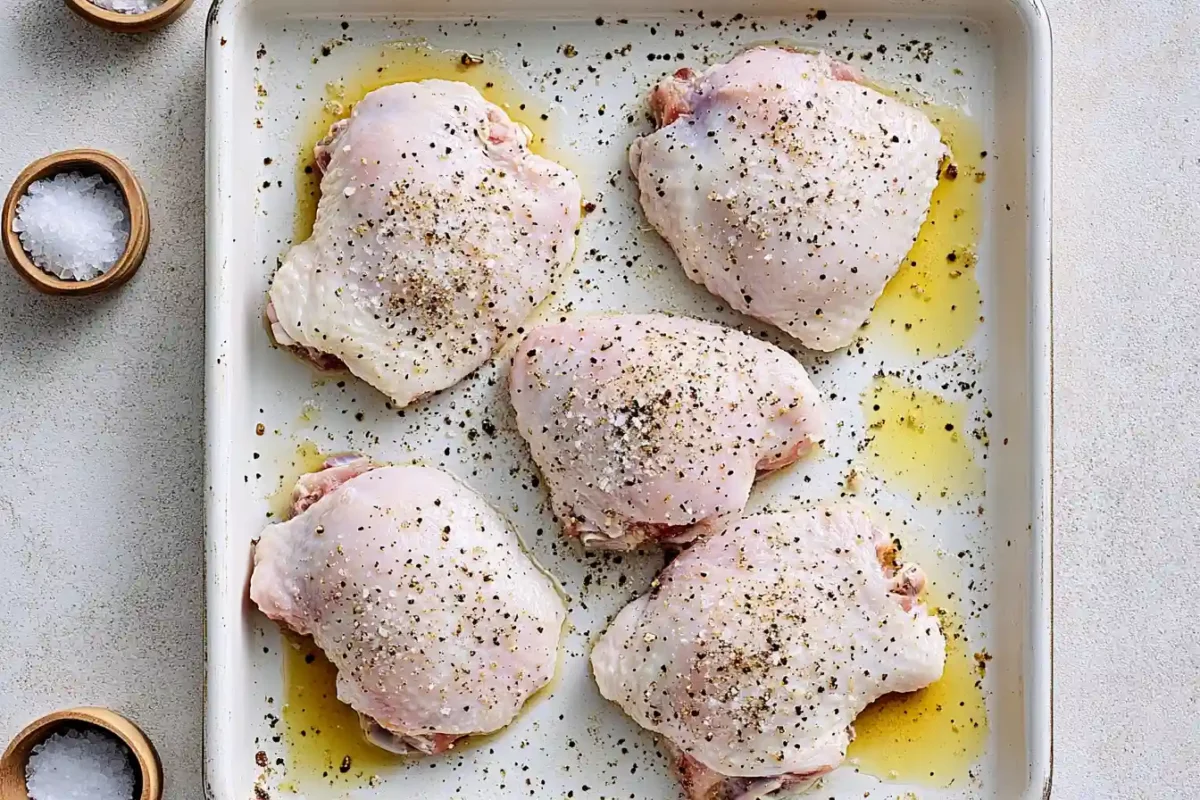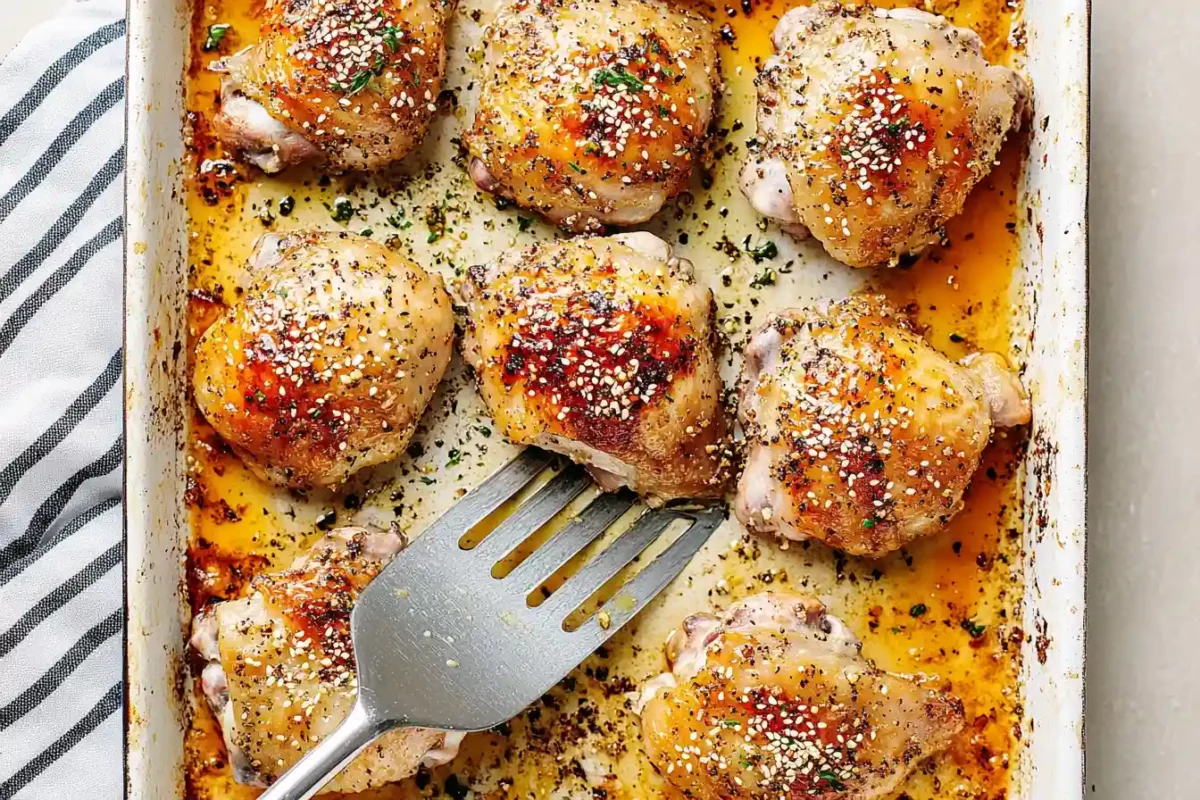What if you could cook chicken thighs so perfectly that every bite is crispy, juicy, and bursting with flavor? Whether you’re a beginner looking to impress your family or a seasoned cook aiming to refine your skills, mastering the best way to cook chicken thighs is easier than you think.
In this guide, you’ll discover step-by-step techniques to achieve restaurant-quality chicken thighs at home. From pan-searing for crispy skin to baking for hands-off convenience, we’ll cover everything you need to know. Plus, you’ll get expert tips, recipe ideas, and common mistakes to avoid—ensuring your chicken thighs turn out flawless every time.
Ready to elevate your cooking game? Grab your skillet, preheat your oven, and let’s get started. Don’t forget to share your results in the comments—we’d love to see your golden, crispy chicken thighs!
Jump to:
Why Chicken Thighs Are a Culinary Favorite
Before we get into the best way to cook chicken thighs, let’s talk about why they’re so popular:
- Rich Flavor: Chicken thighs have a higher fat content than breasts, making them more flavorful and moist.
- Forgiving Texture: They’re harder to overcook, so even beginners can achieve great results.
- Versatility: Chicken thighs work well in a variety of cuisines, from Italian to Asian to Mexican.
- Budget-Friendly: They’re often more affordable than other cuts, making them a great choice for family meals.
Chicken thighs aren’t just flavorful—they’re also packed with nutrients. They’re an excellent source of protein, iron, and zinc, making them a healthy choice for balanced meals. Plus, they’re often more affordable than chicken breasts, so you can feed a crowd without breaking the bank. From Thai curries to Italian cacciatore, chicken thighs are a staple in cuisines worldwide, proving their versatility.
The Best Way to Cook Chicken Thighs: Step-by-Step Guide
1. Choose the Right Chicken Thighs
The first step to cooking perfect chicken thighs is selecting the right cut:
- Bone-In, Skin-On: This is the best option for maximum flavor and juiciness. The skin crisps up beautifully, and the bone adds depth to the meat.
- Boneless, Skinless: A leaner option that’s quicker to cook but requires extra care to prevent dryness.
2. Prep the Chicken Thighs
Proper preparation is key to achieving the best way to cook chicken thighs:
- Pat Dry: Use paper towels to remove excess moisture from the skin. This ensures a crispy exterior.
- Trim Excess Fat: Trim any large pieces of fat to prevent flare-ups (if grilling) or excessive grease.
- Season Generously: Season both sides with salt, pepper, and your favorite spices. For extra flavor, add garlic powder, smoked paprika, or cayenne.
3. Choose Your Cooking Method
The best way to cook chicken thighs depends on your preferred method. Here are three foolproof techniques:
If you’re looking to get the most flavor out of chicken thighs, check out our detailed guide to get the Most Flavor.

Method 1: Pan-Searing for Crispy Skin
Pan-searing is one of the best ways to cook chicken thighs if you love crispy skin and juicy meat.
Steps:
- Heat a heavy skillet (preferably cast iron) over medium-high heat. Add a tablespoon of oil or butter.
- Place the chicken thighs skin-side down in the skillet. Sear for 5-7 minutes until the skin is golden brown and crispy.
- Flip the thighs and cook for another 5-7 minutes, or until the internal temperature reaches 165°F (74°C).
- Optional: Add garlic, thyme, or lemon slices to the pan for extra flavor.
Pro Tip: For even crispier skin, press the thighs gently with a spatula while searing. Wondering whether to bake chicken thighs at 350°F or 400°F? Our comprehensive guide here breaks down the pros and cons of each method to help you decide.
Method 2: Baking for Hands-Off Cooking
Baking is another best way to cook chicken thighs, especially if you’re feeding a crowd.
Steps:
- Preheat your oven to 400°F (200°C).
- Arrange the chicken thighs on a baking sheet or in a baking dish.
- Drizzle with olive oil and season with salt, pepper, and herbs.
- Bake for 25-30 minutes, or until the skin is crispy and the internal temperature reaches 165°F (74°C).
- Optional: Broil for 2-3 minutes at the end for extra crispiness.
Pro Tip: Place the thighs on a wire rack to allow air circulation and ensure even cooking.
Method 3: Grilling for Smoky Flavor
Grilling is the best way to cook chicken thighs if you’re craving a smoky, charred flavor.
Steps:
- Preheat your grill to medium heat (about 375°F/190°C).
- Oil the grill grates to prevent sticking.
- Place the chicken thighs skin-side down on the grill. Cook for 6-8 minutes per side, or until the internal temperature reaches 165°F (74°C).
- Optional: Brush with barbecue sauce or a glaze during the last few minutes of cooking.
Pro Tip: Use indirect heat if flare-ups occur to prevent burning.

Tips for the Best Way to Cook Chicken Thighs
To ensure your chicken thighs turn out perfectly every time, follow these expert tips:
- Use a Meat Thermometer: The safest way to check doneness is by measuring the internal temperature (165°F/74°C).
- Let Them Rest: Allow the chicken to rest for 5-10 minutes after cooking. This helps redistribute the juices for maximum tenderness.
- Baste for Flavor: Spoon pan juices, melted butter, or marinade over the thighs while cooking to keep them moist and flavorful.
- Experiment with Marinades: Try marinades with soy sauce, lemon juice, garlic, and herbs for added depth.
Recipe Ideas to Try
Now that you know the best way to cook chicken thighs, here are a few recipe ideas to inspire you:
1. Sticky Honey Garlic Chicken Thighs
- Marinate the thighs in a mix of honey, soy sauce, garlic, and ginger.
- Pan-sear or bake until caramelized and sticky.
2. Lemon Herb Chicken Thighs
- Season with lemon zest, thyme, rosemary, and olive oil.
- Bake or grill for a bright, aromatic dish.
3. Spicy BBQ Chicken Thighs
- Rub with a mix of smoked paprika, chili powder, and brown sugar.
- Grill and baste with your favorite BBQ sauce.
Recipe Variations to Inspire Your Next Meal
Looking for more ways to enjoy chicken thighs? These recipe variations will take your cooking to the next level, offering bold flavors and creative twists to suit every palate. Whether you’re craving something fresh and tangy, rich and comforting, or bold and spicy, there’s a recipe here for you.
1. Mediterranean-Style Chicken Thighs
Bring the flavors of the Mediterranean to your table with this vibrant recipe:
- Ingredients: Bone-in chicken thighs, Kalamata olives, cherry tomatoes, red onion, feta cheese, lemon juice, olive oil, oregano, and garlic.
- Method: Sear the chicken thighs until golden, then transfer to a baking dish. Add olives, tomatoes, red onion, and garlic around the thighs. Drizzle with olive oil and lemon juice, then sprinkle with oregano. Bake at 375°F (190°C) for 25-30 minutes. Top with crumbled feta before serving.
- Serving Suggestion: Pair with couscous or a Greek salad for a complete meal.
2. Asian-Inspired Chicken Thighs
This recipe is perfect for fans of bold, umami flavors:
- Ingredients: Boneless chicken thighs, soy sauce, sesame oil, honey, garlic, ginger, green onions, and sesame seeds.
- Method: Whisk together soy sauce, sesame oil, honey, minced garlic, and grated ginger. Marinate the chicken thighs for at least 30 minutes. Grill or pan-sear the thighs until caramelized, then garnish with sliced green onions and sesame seeds.
- Serving Suggestion: Serve with steamed jasmine rice and stir-fried vegetables for an authentic Asian-inspired meal.
3. Comfort Food Chicken Thighs with Creamy Mushroom Sauce
Indulge in a cozy, comforting dish that’s perfect for chilly evenings:
- Ingredients: Bone-in chicken thighs, mushrooms, garlic, thyme, heavy cream, chicken broth, and butter.
- Method: Sear the chicken thighs until golden, then set aside. In the same pan, sauté sliced mushrooms with garlic and thyme until tender. Add chicken broth and heavy cream, then simmer until the sauce thickens. Return the chicken to the pan and cook until heated through.
- Serving Suggestion: Serve with creamy mashed potatoes and steamed green beans for a hearty, satisfying meal.
4. Spicy Cajun Chicken Thighs
Add a kick to your dinner with this spicy Cajun-inspired recipe:
- Ingredients: Chicken thighs, Cajun seasoning, paprika, garlic powder, onion powder, cayenne pepper, and olive oil.
- Method: Rub the chicken thighs with a mix of Cajun seasoning, paprika, garlic powder, onion powder, and cayenne. Pan-sear or grill until crispy and cooked through.
- Serving Suggestion: Pair with coleslaw and cornbread for a Southern-inspired feast.
5. Lemon Herb Chicken Thighs
Bright, fresh, and aromatic, this recipe is a crowd-pleaser:
- Ingredients: Chicken thighs, lemon zest, lemon juice, olive oil, garlic, rosemary, thyme, and parsley.
- Method: Marinate the chicken thighs in a mixture of lemon zest, lemon juice, olive oil, minced garlic, and chopped herbs for at least 30 minutes. Bake or grill until golden and juicy.
- Serving Suggestion: Serve with roasted vegetables or a fresh arugula salad for a light, flavorful meal.
6. BBQ Glazed Chicken Thighs
Sweet, smoky, and irresistible, this recipe is perfect for summer cookouts:
- Ingredients: Chicken thighs, BBQ sauce, brown sugar, smoked paprika, garlic powder, and apple cider vinegar.
- Method: Rub the chicken thighs with a mix of smoked paprika and garlic powder. Grill or bake until nearly cooked through, then brush with a glaze made from BBQ sauce, brown sugar, and apple cider vinegar. Cook until caramelized.
- Serving Suggestion: Serve with coleslaw and grilled corn on the cob for a classic BBQ meal.
Conclusion:
Mastering the best way to cook chicken thighs is all about understanding the cut, using the right techniques, and adding your personal touch. From achieving crispy skin through pan-searing to infusing smoky flavors on the grill, this guide has shown you how to create juicy, flavorful chicken thighs every time. Whether you’re cooking for a weeknight dinner or a special occasion, these methods ensure your chicken thighs will be a hit.
Final Thoughts:
Cooking chicken thighs doesn’t have to be complicated. With a little practice and the right approach, you can turn this humble cut into a show-stopping dish. The key is to focus on preparation, seasoning, and cooking techniques that highlight the natural richness of the meat.
Call to Action:
Now it’s your turn! Which method are you excited to try—crispy pan-seared thighs, smoky grilled ones, or hands-off baked thighs? Share your cooking experiences, tips, or photos in the comments below. Would you try this? Tell us below!

